BUICK CENTURY 1994 Manual PDF
Manufacturer: BUICK, Model Year: 1994, Model line: CENTURY, Model: BUICK CENTURY 1994Pages: 308, PDF Size: 16.3 MB
Page 71 of 308
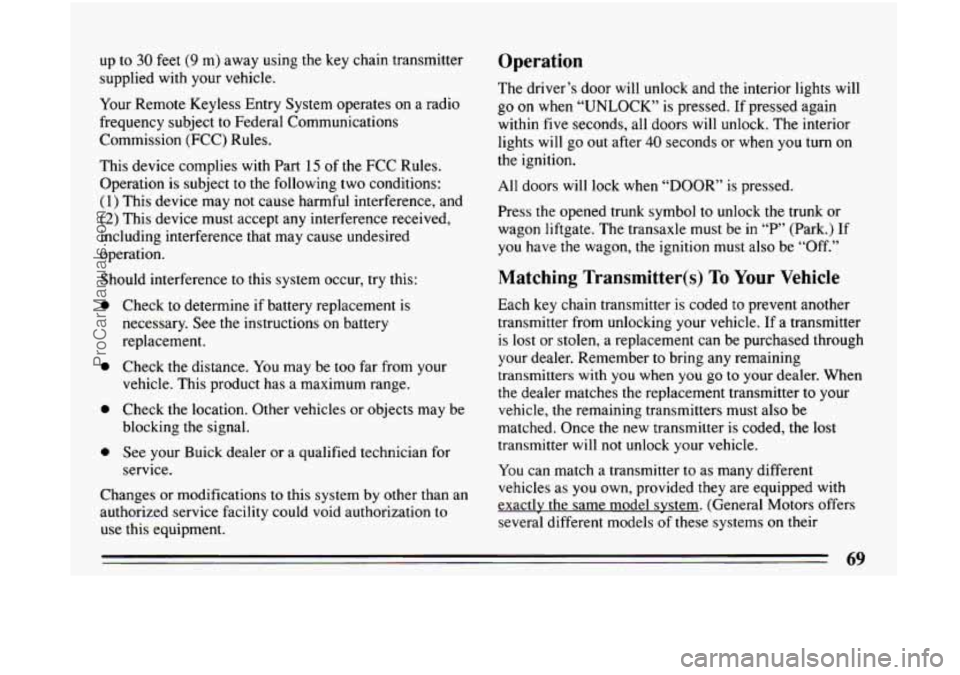
up to 30 feet (9 m) away using the key chain transmitter
supplied with your vehicle.
Your Remote Keyless Entry System operates on a radio
frequency subject to Federal Communications
Commission (FCC) Rules.
This device complies with Part
15 of the FCC Rules.
Operation is subject to the following two conditions:
(1) This device may not cause harmful interference, and
(2) This device must accept any interference received,
including interference that may cause undesired
operation.
Should interference to this system occur, try this:
e
e
e
0
Check to determine if battery replacement is
necessary. See the instructions on battery
replacement.
Check the distance. You may be
too far from your
vehicle. This product has a maximum range.
Check the location. Other vehicles or objects may be
blocking
the signal.
See your Buick dealer or a qualified technician for
service.
Changes or modifications
to this system by other than an
authorized service facility could void authorization
to
use this equipment.
Operation
The driver’s door will unlock and the interior lights will
go
on when “UNLOCK” is pressed. If pressed again
within five seconds, all doors will unlock.
The interior
lights will go out after
40 seconds or when you turn on
the ignition.
All doors will lock when “DOOR”
is pressed.
Press the opened trunk symbol to unlock the trunk or
wagon liftgate. The transaxle must be in “P” (Park.) If
you have the wagon, the ignition must also be “Off.”
Matching Transmitter(s) To Your Vehicle
Each key chain transmitter is coded to prevent another
transmitter from unlocking your vehicle. If
a transmitter
is lost or stolen, a replacement can be purchased through
your dealer. Remember
to bring any remaining
transmitters with you when
you go to your dealer. When
the dealer matches the replacement transmitter to your
vehicle, the remaining transmitters must also be
matched. Once the new transmitter
is coded, the lost
transmitter will not unlock your vehicle.
You can match a transmitter
to as many different
vehicles as you own, provided they are equipped with
exactly the same model system. (General Motors offers
several different models
of these systems on their
69
ProCarManuals.com
Page 72 of 308
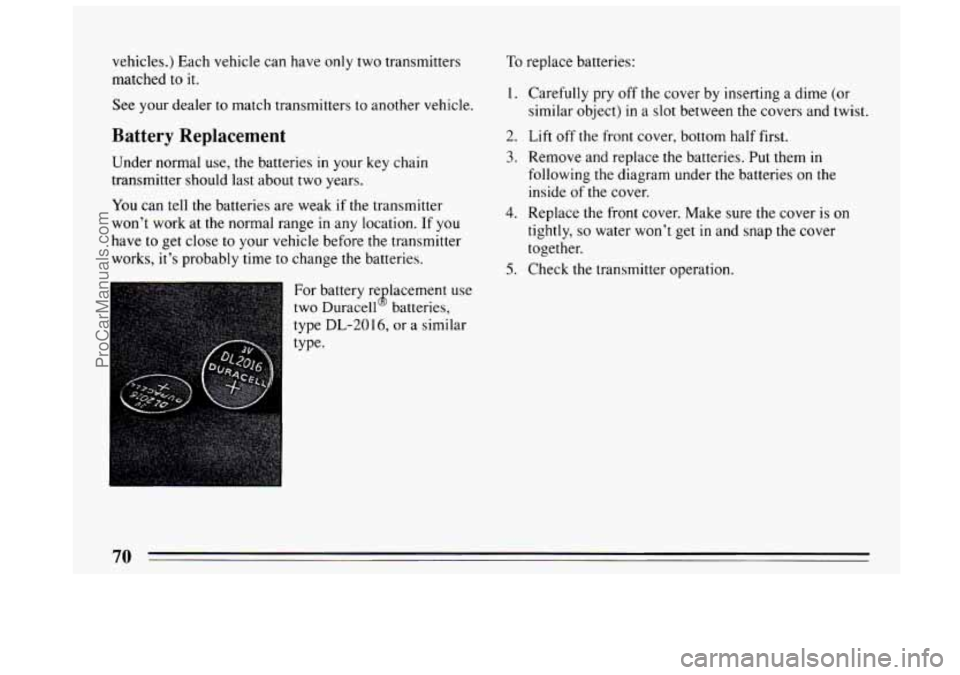
vehicles.) Each vehicle can have only two transmitters
matched to
it.
See your dealer to match transmitters to another vehicle.
Battery Replacement
Under normal use, the batteries in your key chain
transmitter should last about two years.
You can tell the batteries are weak if the transmitter
won’t work at the normal range in any location. If you
have
to get close to your vehicle before the transmitter
works, it’s probably time
to change the batteries.
To replace batteries:
1.
2.
3.
4.
5.
Carefully pry off the cover by inserting a dime (or
similar object)
in a slot between the covers and twist.
Lift off the front cover, bottom half first.
Remove and replace the batteries. Put them in
following the diagram under the batteries on the
inside of the cover.
Replace the front cover. Make sure the cover
is on
tightly,
so water won’t get in and snap the cover
together.
Check the transmitter operation.
For battery re lacernent use
two Duracell batteries,
type
DL-20 16, or a similar
type.
8
70
ProCarManuals.com
Page 73 of 308
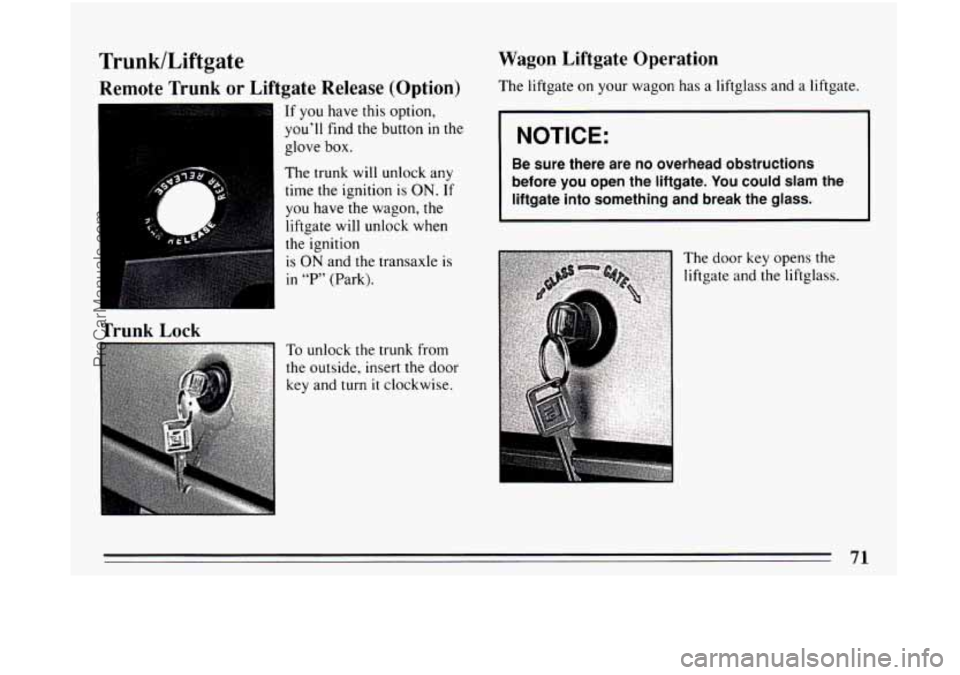
Trunk/Liftgate
Remote Trunk or Liftgate Release (Option)
If you have this option,
you’ll find the button
in the
glove
box.
The trunk will unlock any
time the ignition is
ON. If
you have the wagon, the
liftgate will unlock when
the ignition
’ is ON and the transaxle is
~ in “P’ (Park).
Trunk Lock
Wagon Liftgate Operation
The liftgate on your wagon has a liftglass and a liftgate.
r
NOTICE:
Be sure there are no overhead obstructions
before you open the liftgate.
You could slam the
liftgate into something and break the glass.
The door key opens the
liftgate and the liftglass.
71
ProCarManuals.com
Page 74 of 308
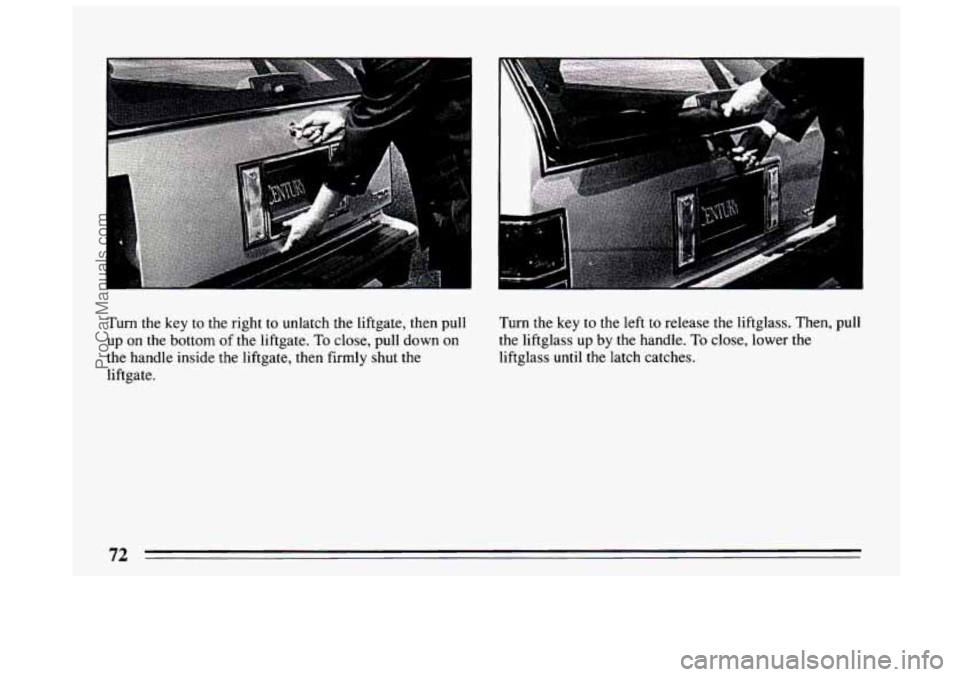
Turn the key to the right to unlatch the liftgate, then pull
up on the bottom of the liftgate.
To close, pull down on
the handle inside the liftgate, then firmly shut the
liftgate. Turn
the key to the left to release the liftglass. Then, pull
the liftglass up by the handle. To close, lower the
liftglass until the latch catches.
72
ProCarManuals.com
Page 75 of 308
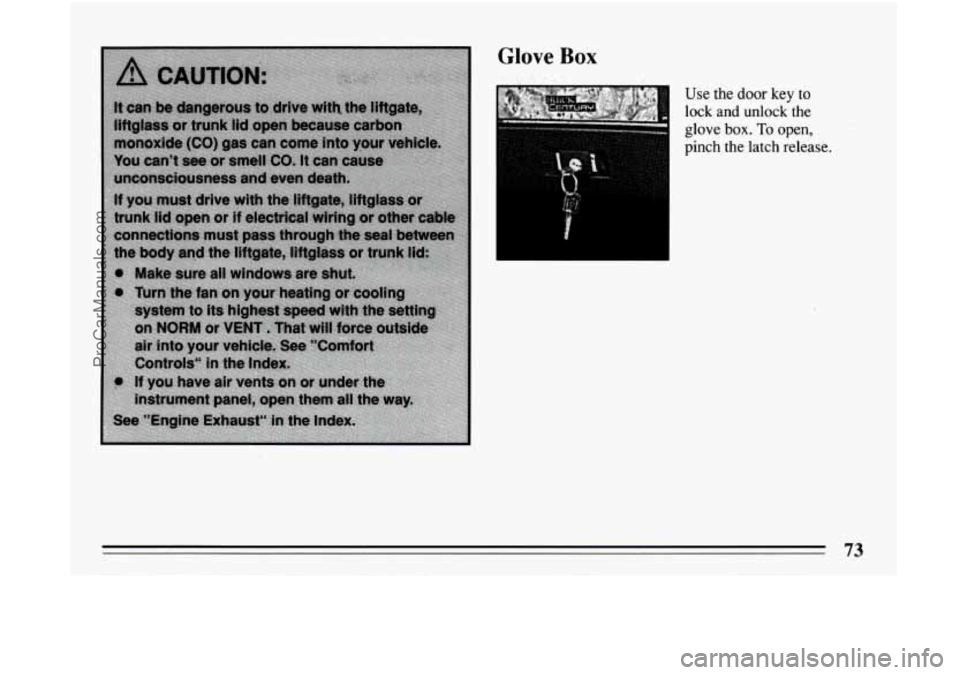
Glove Box
Use the door key to
lock and unlock the
- glove box. To open,
pinch the latch release.
73
ProCarManuals.com
Page 76 of 308
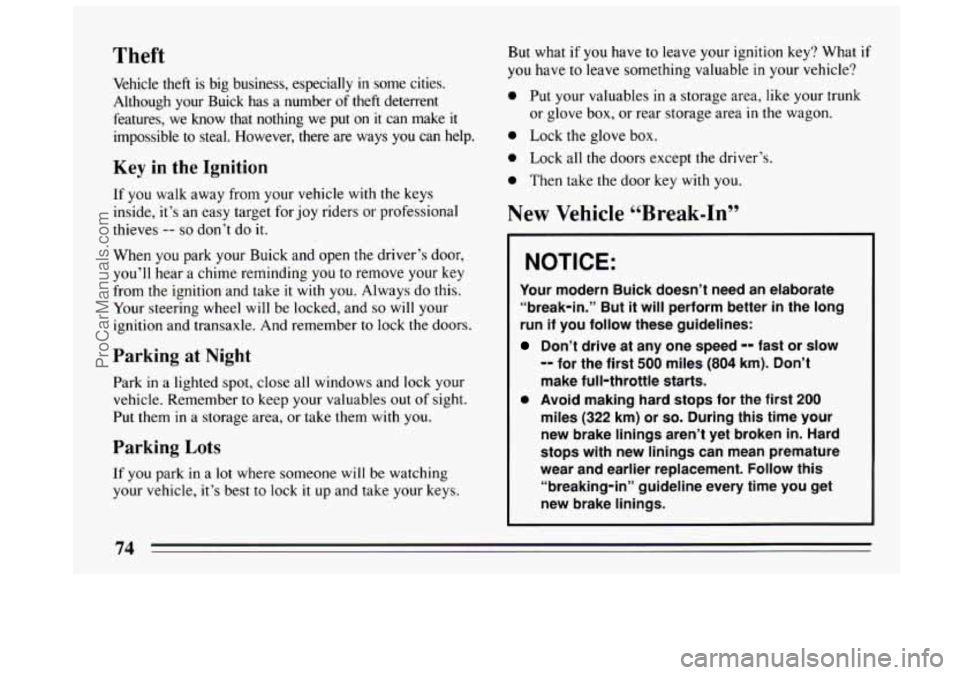
Theft
Vehicle theft is big business, especially in some cities. Although your Buick has a number of theft deterrent
features, we know that nothing we put on it can make
it
impossible to steal. However, there are ways you can help.
Key in the Ignition
If you walk away from your vehicle with the keys
inside, it’s an easy target for joy riders or professional
thieves
-- so don’t do it.
When you park your Buick and open the driver’s door,
you’ll hear a chime reminding you to remove your key
from the ignition and take it
with you. Always do this.
Your steering wheel
will be locked, and so will your
ignition and transaxle. And remember to lock the doors.
Parking at Night
Park in a lighted spot, close all windows and lock your
vehicle. Remember to keep your valuables out
of sight.
Put them
in a storage area, or take them with you.
Parking Lots
If you park in a lot where someone will be watching
your vehicle, it’s best to lock
it up and take your keys. But what
if
you have to leave your ignition key? What if
you have to leave something valuable in your vehicle?
0 Put your valuables in a storage area, like your trunk
or glove box, or rear storage area in the wagon.
0 Lock the glove box.
0 Lock all the doors except the driver’s.
0 Then take the door key with you.
New Vehicle “Break-In”
I NOTICE:
Your modern Buick doesn’t need an elaborate
“break-in.” But
it will perform better in the long
run if you follow these guidelines:
Don’t drive at any one speed -- fast or slow
-- for the first 500 miles (804 km). Don’t
make full-throttle starts.
0 Avoid making hard stops for the first 200
miles (322 km) or so. During this time your
new brake linings aren’t yet broken
in. Hard
stops with new linings can mean premature
wear and earlier replacement. Follow this
“breaking-in” guideline every time you get
new brake linings.
74
ProCarManuals.com
Page 77 of 308
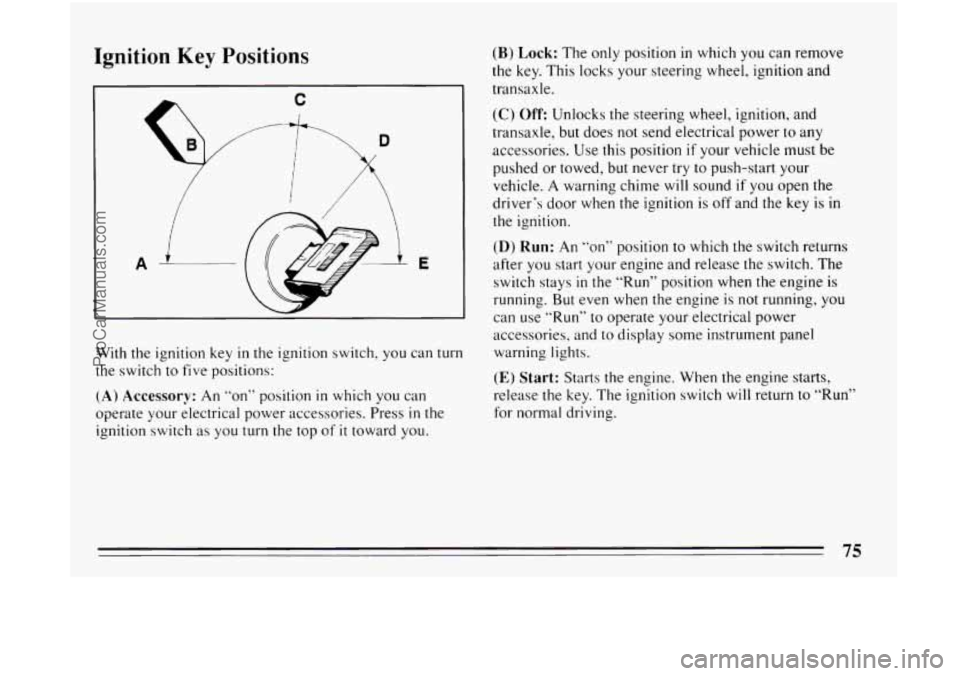
Ignition Key Positions
C
9.5 B
A i E
With the ignition key in the ignition switch, you can turn
the switch to five positions:
(A) Accessory: An “on” position in which you can
operate your electrical power accessories. Press
in the
ignition switch as you turn the top
of it toward you.
(B) Lock: The only position in which you can remove
the key. This locks
your steering wheel, ignition and
transaxle.
(C) Off: Unlocks the steering wheel, ignition, and
transaxle, but does not send electrical power
to any
accessories. Use this position
if your vehicle must be
pushed or towed, but never
try to push-start your
vehicle.
A warning chime will sound if you open the
driver’s door when the ignition is off and the
key is in
the ignition.
(D) Run: An ‘‘on’’ position to which the switch returns
after you start your engine and release
the switch. The
switch stays
in the “Run” position when the engine is
running. But even when the engine is
not running, you
can use
“Run” to operate your electrical power
accessories, and to display some instrument panel
warning lights.
(E) Start: Starts the engine. When the engine starts,
release the key. The ignition switch will return
to “Run”
for normal driving.
ProCarManuals.com
Page 78 of 308
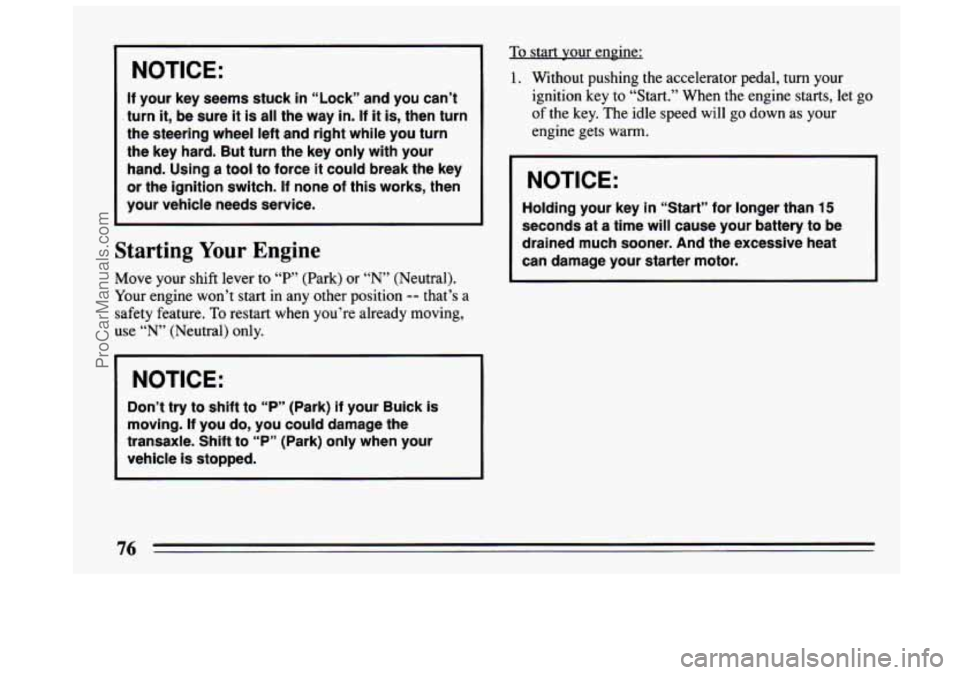
NOTICE:
If your key seems stuck in “Lock” and you can’t
. turn it, be sure it is all the way in. If it is, then turn
the steering wheel left and right while you turn
the key hard. But turn the key only with your
hand. Using a tool to force it could break the key
or the ignition switch. If none of this works, then
your vehicle needs service.
Starting Your Engine
Move your shift lever to “P” (Park) or “N” (Neutral).
Your engine won’t start in any other position
-- that’s a
safety feature. To restart when you’re already moving,
use
“N’ (Neutral) only.
NOTICE:
Don’t try to shift to “P” (Park) if your Buick is
moving.
If you do, you could damage the
transaxle. Shift to
“P” (Park) only when your
vehicle is stopped.
To start your engine:
1. Without pushing the accelerator pedal, turn your
ignition key to “Start.” When the engine starts,
let go
of the key. The idle speed will go down as your
engine gets warm.
NOTICE:
Holding your key in “Start” for longer than 15
seconds at a time will cause your battery to be
drained much sooner. And the excessive heat
can damage your starter motor.
76
ProCarManuals.com
Page 79 of 308
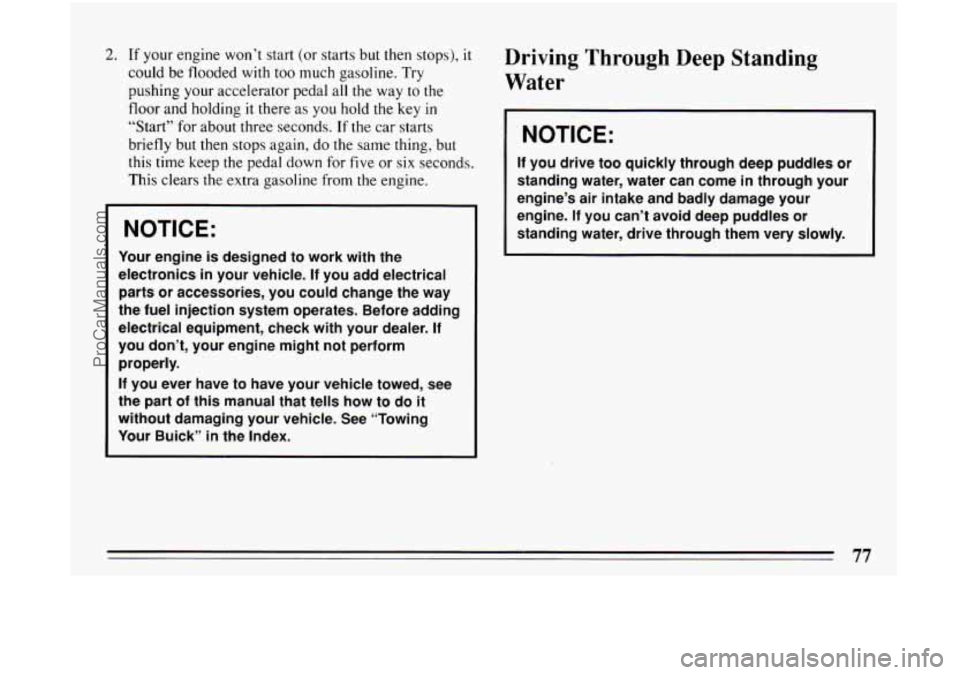
2. If your engine won’t start (or starts but then stops), it
could be flooded with too much gasoline. Try
pushing your accelerator pedal
all the way to the
floor and holding it there as you hold the key in
“Start” for about three seconds. If the car starts
briefly but then stops again, do the same thing, but
this time keep
the pedal down for five or six seconds.
This clears the extra gasoline from the engine.
I NOTICE:
Your engine is designed to work with the
electronics
in your vehicle. If you add electrical
parts or accessories, you could change the way
the fuel injection system operates. Before adding
electrical equipment, check with your dealer.
If
you don’t, your engine might not perform
properly.
If you ever have to have your vehicle towed, see
the part
of this manual that tells how to do it
without damaging your vehicle. See “Towing
Your Buick”
in the Index.
Driving Through Deep Standing
Water
I NOTICE:
If you drive too quickly through deep puddles or
standing water, water can come
in through your
engine’s air intake and badly damage your
engine.
If you can’t avoid deep puddles or
standing water, drive through them very slowly.
77
ProCarManuals.com
Page 80 of 308
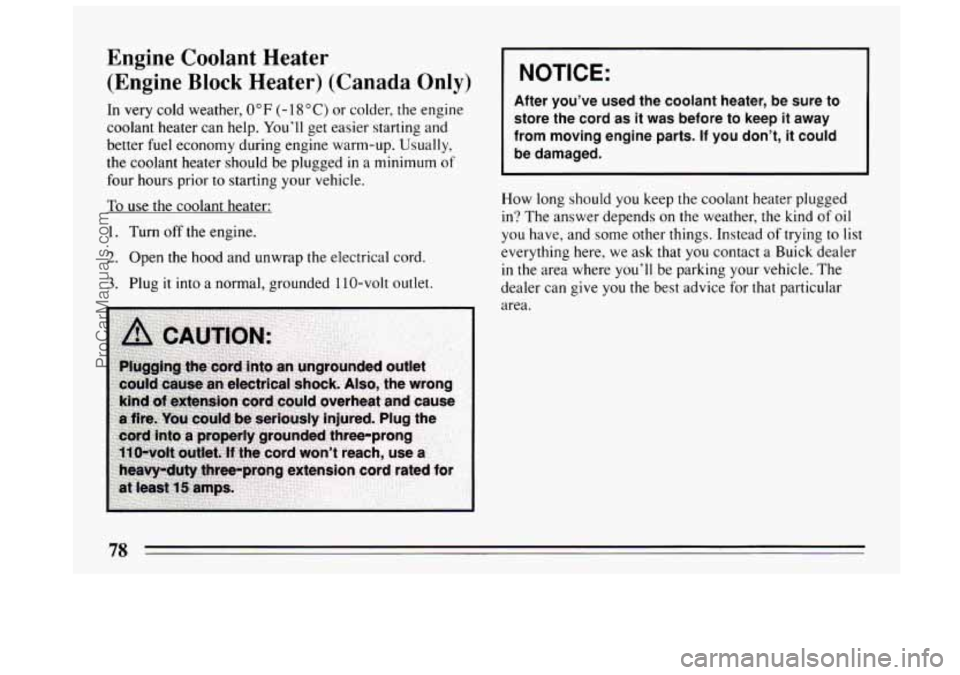
Engine Coolant Heater (Engine Block Heater) (Canada Only)
In very cold weather, 0°F (-18°C) or colder, the engine
coolant heater can help. You’ll get easier starting and
better fuel economy during engine warm-up. Usually,
the coolant heater should be plugged
in a minimum of
four hours prior to starting your vehicle.
To use the coolant heater:
1. Turn off the engine.
2. Open the hood and unwrap the electrical cord.
3. Plug it into a normal, grounded 110-volt outlet.
I NOTICE:
After you’ve used the coolant heater, be sure to
store the cord
as it was before to keep it away
from moving engine parts. If you don’t, it could
be damaged.
How long should you keep the coolant heater plugged
in? The answer depends on the weather, the kind
of oil
you have, and some other things. Instead of trying to list
everything here, we ask that you contact a Buick dealer
in the area where you’ll be parking your vehicle. The
dealer can give you the best advice for that particular
area.
78
ProCarManuals.com